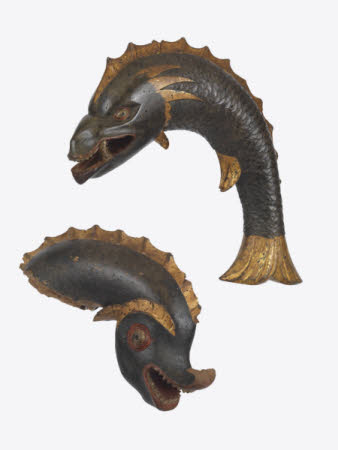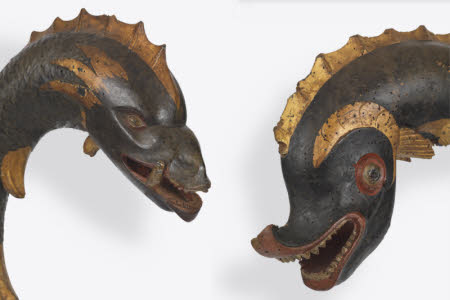Helmet crest
Category
Wooden objects
Date
c. 1608
Materials
Wood, gilding and polychromy
Measurements
180 x 330 x 90 mm
Order this imageCollection
Godolphin, Cornwall
NT 169409
Caption
Carved wooden beasts like these were originally designed to sit on top of armoured helmets worn at ceremonial events and court contests. However, these dolphins were probably used on helmets prominently displayed at the funerals of members of the Godolphin family. The dolphin emblem was chosen as a pun on the family name and also alluded to the fact that they owned large stretches of the Cornish coast. The earliest crest is similar to those worn at court jousts in front of Queen Elizabeth I and appears to have belonged to Sir William Godolphin (c.1518–70), who served the Crown in various offices. As recognisable heraldic symbols, such crests could convey association with landed families across time. These emblems appeared in seal rings (used to seal correspondence), as well as on servant livery, horses and coaches, and were often carved or engraved onto architectural features.
Summary
Heraldic helmet crest, circa 1608, in the form of a dolphin and probably relating to Sir Francis Godolphin (c.1534-1608). The carved wooden dolphin, which lacks its tail and part of its nose, is painted and parcel-gilt. The mouth is open to reveal teeth. The fins are gilded, while the body of the dolphin is black. There is significant insect damage which has resulted in the losses.
Full description
This and a similar, slightly earlier version (NT 169408) are carved wooden representations of the dolphin which formed the crest of the Godolphins, a play on words typical of heraldry. They are likely to have been made as part of the funerary accoutrements of members of the family who had owned the eponymous Godolphin estate in Cornwall since the Norman period. The full, heraldic description of the crest of the Godolphin family is, according to Fairbairn’s Crests: ‘a dolphin, sable, finned or’. This means that the creature should be depicted as painted black with gold fins. Crests, to be placed on top of the helmet, developed from the late 12th century and rather than being a practical symbol of the knight’s identity on the battlefield, as is often suggested, they were much more likely to have been primarily an expression of ‘the peacock-popinjay vanity ingrained in human nature’, as it was put by the great authority on heraldry, Arthur Fox-Davies. In mediaeval and Tudor England they would have been most prominently displayed at court jousts or in processions, including those for funerals. From the late 16th century their use expanded from the nobility and knights to all those with heraldic bearings. By the 16th century the Godolphins were the most powerful family of the west of the county and the later crest is likely to relate to Sir Francis Godolphin (c. 1534-1608). He succeeded his uncle, Sir William (d. 1570) who was in favour under Henry VIII, Edward VI and Elizabeth. Sir Francis followed his uncle into parliament and was leased the Scilly Isles in succession to him too. He was connected by marriage or blood to most of the other major Cornish gentry families and he appears to have been a staunch protestant. During his time the tin and silver mines of the Godolphin family employed 300 men and in 1584 it was reported that the ore extracted produced 30 lb of silver per cwt. During the Anglo-Spanish War, including the Armada, his responsibilities as Deputy Lieutenant for the County included beacons and the fortification of ports and he 'engaged himself very worthily' at Penzance in July, 1595 when a Spanish force landed in Cornwall. Sir Francis was buried at Breage, in which parish Godolphin House lies, on the 23rd April 1608. As he was an armigerous knight of great significance there would have been a magnificent and colourful heraldic funeral orchestrated by the College of Arms, with standards, banners, an actual shield painted with his arms and, ahead of the coffin, borne by heralds, a sword and his helm or helmet topped by a wooden representation of the dolphin family crest. These then featured in the funeral service and would have ended by being placed on Sir William’s tomb in the Godolphin chapel. It was common practice for all or part of this paraphernalia to be set up on the wall of the church thereafter, supported by iron embrasures, and there are numerous examples surviving in situ throughout England. Strangely, for a family of the prominence of the Godolphins, no tombs survive in Breage church and they perhaps succumbed to Protestant zeal during the Commonwealth. There were, however, still three helms there in 1913 when H. R. Coulthard published his history of the parish and the crests at Godolphin today may well have come from them. Coulthard included a photograph of one helm, complete with its crest. The crests are reputed to have been bought at auction by Mrs Mary Schofield and were acquired by the National Trust with Godolphin House in 2007. They are displayed in the dining room.
Provenance
Formerly owned by Mrs Mary Schofield and believed to have been bought by her at auction. Acquired by the National Trust with Godolphin House in 2007.
Credit line
Godolphin House, the Schofield Collection (National Trust)


